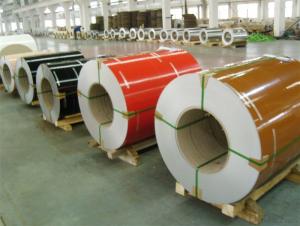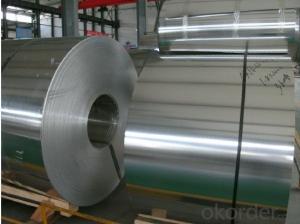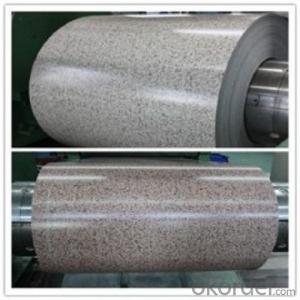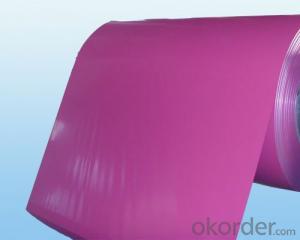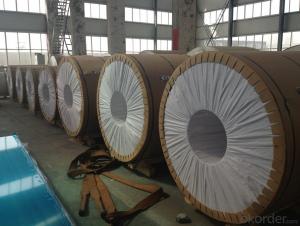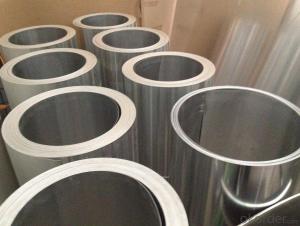Prepainted Aluminum Coil for Roller Shutter
- Loading Port:
- Shanghai
- Payment Terms:
- TT or LC
- Min Order Qty:
- 8 m.t.
- Supply Capability:
- 5000 m.t./month
OKorder Service Pledge
OKorder Financial Service
You Might Also Like
Specification
Structure of Prepainted Aluminum Coil for Roller Shutter Description:
Coated aluminum coil/sheet are of a wide range of colors, which gives wonderful appearance no matter in residential and commercial constructions of great exhibition centers.
Interior: wall cladding, ceilings, bathrooms, kitchens and balconies, shutters, doors...
Exterior: wall cladding, facades, roofing, canopies, tunnels,column covers , renovations...
Advertisement: display platforms, signboards, fascia, shop fronts...
Main Features of the Prepainted Aluminum Coil for Roller Shutter:
Enviromental, light weight, waterproof, fireproof, anti-rust, weather resistance, easy cleaning, easy matching with other decoration materials...
Images of Prepainted Aluminum Coil for Roller Shutter:
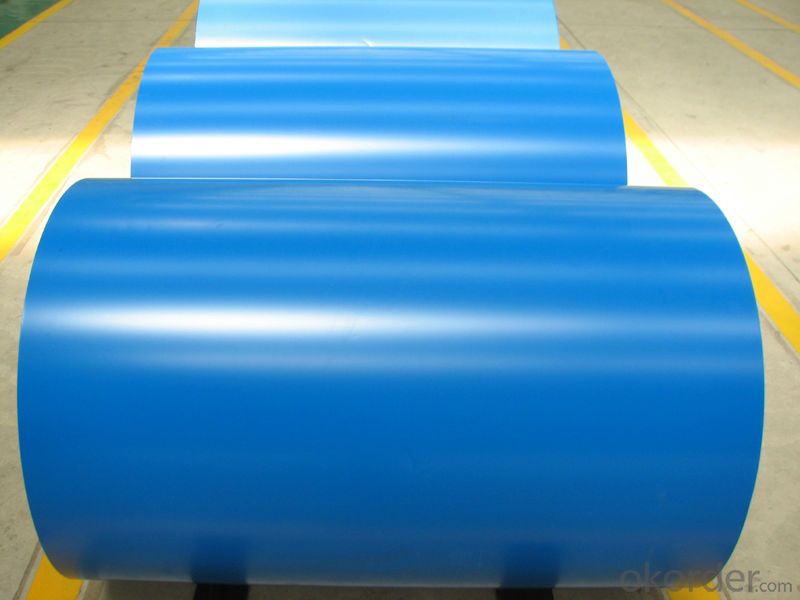
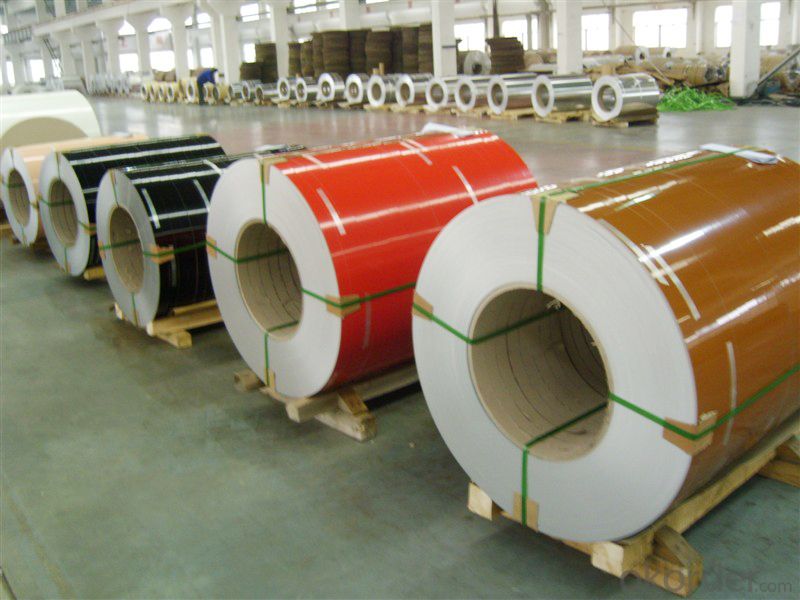
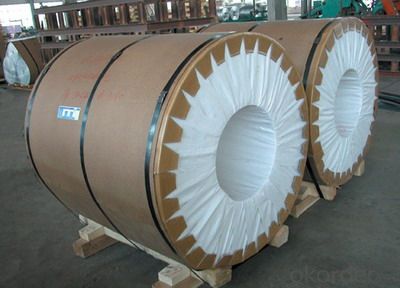
Prepainted Aluminum Coil for Roller Shutter Specifications:
| Item | Test Item | Standard | National standard | DF Test Result |
| 1 | Color Difference | ECCA T3 | Δ E≤ 2.0 | Δ E≤ 1.5 |
| 2 | Gloss Difference | ECCA T2 | ≤ 10 | ≤ 5 |
| 3 | Coating Thickness | ECCA T1 | Two layers Min 23um | ≥ 24um |
| Three layers Min 30um | ≥ 33um | |||
| 4 | Pencil Hardness | ASTM D3363 | ≥ HB | HB |
| 5 | T-bend | ASTM D4145 | ≤ 2T | ≤ 2T |
| 6 | Adhesion | ASTM D3359 | Grade 0 | Grade 0 |
| 7 | Impact | ASTM D2794 | ≥ 50 kg/cm | ≥ 50 kg/cm |
| 8 | Boiling water Resistance | GB/T17748 | 2h No Change | 4h No Change |
| 9 | Solvent Resistance | ASTM D2248 | 200 times paints remaining | 500 times no break |
| 10 | Acidity Resistance | ASTM D1308 | 5%HCL 24hrs no change | No change |
| 11 | Alkali Resistance | ASTM D1308 | 5%NaOH 24hrs no change color Δ E≤ 2.0 | No change |
| 12 | Nitric acid Resistance | AAMA620 | Δ E≤ 5.0 | Δ E≤ 5.0 |
| 13 | Oil Resistance | ASTM D1308 | 20# oil 24hrs no change | No change |
| 14 | Salt Spray Resistance | ASTM B117 | 4000hrs≤ Grade 1 | No change |
| 15 | Abrasion resistance | ASTM D968 | ≥ 5L/um | ≥ 5L/um |
| 16 | Dirt Resistance | GB/T9780 | ≤ 5% | < 5% |
| 17 | Color retaining | GB/T16259 | 4000 hrsΔ E≤ 4.0 | 4000 hrsΔ E≤ 3.0 |
| 18 | Gloss weaken Level | GB/T16259 | 4000 hrs ≤ Grade 2 | 4000 hrs ≤ Grade 2 |
FAQ :
a.What is monthly capacity
---CNBM is one stated own company and our monthly capacity is about 2000tons.
b. Now which countries do you export your goods?
---Now we export to South East Asia,Africa, North America,South America ect.
- Q: Can aluminum material be utilized as a baking surface for bread?
- <p>Aluminum coils are not typically used for baking bread. While aluminum is a good conductor of heat and is used in baking sheets and muffin tins, it's usually in a flat, solid form. Aluminum coils, often used for industrial purposes like heat exchangers, are not designed for direct food contact. For baking bread, it's best to use materials specifically designed for baking, such as silicone mats, parchment paper, or non-stick baking sheets. These materials are safe for food contact and can withstand the high temperatures required for baking bread.</p>
- Q: What is the weight of aluminum coils per square foot?
- The weight per square foot of aluminum coils may differ based on the coil's thickness. Typically, aluminum coils have an average weight of approximately 0.5 pounds per square foot. Nevertheless, it is crucial to mention that this value is an approximation and might slightly fluctuate depending on the particular alloy and manufacturing procedure applied. It is always advisable to consult the manufacturer or supplier to obtain precise weight specifications for the aluminum coils you are dealing with.
- Q: How are aluminum coils tested for flatness?
- Aluminum coils are typically tested for flatness using a variety of methods, including visual inspection, mechanical measurement, and advanced technologies like laser scanning. The visual inspection involves examining the surface of the coil for any visible signs of waviness or distortion. Mechanical measurement techniques involve placing the coil on a flat surface and using specialized tools to measure its flatness by checking for any deviations from the ideal flat plane. Laser scanning is another method where a laser beam is directed across the surface of the coil, and the reflected beam is analyzed to determine the flatness of the coil. These testing methods ensure that aluminum coils meet the required flatness standards for their intended applications.
- Q: How are aluminum coils used in the manufacturing of cookware?
- Aluminum coils are widely used in the manufacturing of cookware due to their excellent heat conductivity and lightweight nature. Cookware manufacturers typically use aluminum coils as the primary material for constructing the bases and bodies of pots, pans, and other cooking utensils. Firstly, aluminum coils are rolled out and then cut into different shapes and sizes depending on the desired cookware product. These coils are preferred over other materials, such as stainless steel or cast iron, because aluminum conducts heat more efficiently. This allows for even distribution of heat across the surface of the cookware, ensuring that food cooks evenly and thoroughly. Additionally, aluminum coils are lightweight, making the resulting cookware easier to handle and maneuver. This is particularly beneficial for professional chefs and home cooks who often need to lift and move pots and pans during the cooking process. Moreover, aluminum is a malleable material, meaning it can be easily shaped and formed into various cookware designs and styles. Whether it's a saucepan, frying pan, or baking tray, aluminum coils can be molded to create the desired shape and size, allowing for versatility in cookware manufacturing. Furthermore, aluminum has a natural resistance to corrosion, making it a durable choice for cookware. It does not react with acidic or alkaline ingredients commonly used in cooking, ensuring that the cookware remains safe for food preparation and cooking. Lastly, aluminum coils can be treated with non-stick coatings, such as Teflon, to create non-stick cookware. These coatings provide an additional layer of convenience, allowing for easy food release and hassle-free cleaning. In summary, aluminum coils play a crucial role in the manufacturing of cookware by providing excellent heat conductivity, lightweight construction, versatility in design, durability, and the option for non-stick coatings. These qualities make aluminum coils an ideal choice for producing high-quality cookware that delivers superior cooking performance and convenience in the kitchen.
- Q: why do we use copper more than aluminum? give some characteristic of copper that makes it better then aluminum?
- I think the major characteristic of copper, when compared to aluminum, is copper's lack of chemical reactivity. When someone mines for copper, you dig out actual pieces of copper metal, which are then cleaned and purified. No one goes mining for aluminum because there is no metal in the ground. Aluminum is so chemically reactive that in a short period of time (by this I mean years, so the short is a relative term compared to copper), all the aluminum metal will react and the metal will be destroyed. Aluminum metal used to be so difficult to make (you have to do it chemically because you can't dig it out of the ground), that kings would serve their important guests on gold and silver plates, but their REALLY important guests got served on aluminum plates. One note on the reactivity of aluminum. Soda cans (made of aluminum) have a thin plastic film which coats the inside of the can, do so as to protect the metal from the chemical action of the soda. If this film were not there, the acidic soda would react with the can in a matter of hours or days and form a hole through which the contents of the can would drain out. Not good!
- Q: Is it safe and effective to use aluminum coil for baking purposes?
- <p>Yes, aluminum coil can be used for baking. It is a common material in baking due to its excellent heat conductivity, which allows for even heating and browning of baked goods. However, it's important to ensure that the aluminum coil is food-grade and clean to avoid any contamination. Additionally, some people may be concerned about potential health risks associated with aluminum, although these concerns are generally considered minimal when using aluminum cookware for baking.</p>
- Q: Are aluminum coils available in different colors?
- Yes, aluminum coils are available in different colors. The process of coloring aluminum coils involves coating the surface with a durable finish that can be in various colors. This coating is typically achieved through a process called coil coating, where the aluminum coil is cleaned, pre-treated, and then coated with a layer of paint or other colored material. This allows for a wide range of colors to be applied to the aluminum coils, providing flexibility in design and aesthetic options for various applications.
- Q: This question asks for a comparison between single-coil and multi-coil aluminum tubes, highlighting their differences.
- <p>Single-coil aluminum tubes are made with a single layer of aluminum wound into a cylindrical shape, offering simplicity and ease of manufacturing. They are typically used in applications requiring basic heat exchange or formwork. In contrast, multi-coil aluminum tubes consist of multiple layers of aluminum wound together, which can provide greater strength and durability. They are often utilized in more demanding applications where higher pressure resistance and thermal efficiency are required, such as in high-performance heat exchangers or industrial processes. The multi-coil design also allows for better heat distribution and can handle more stress without deformation.</p>
- Q: What is the fatigue strength of aluminum coils?
- Various factors, including the specific alloy used, the manufacturing process, and the application, can cause the fatigue strength of aluminum coils to vary. In comparison to other materials, aluminum alloys generally possess good fatigue strength, making them appropriate for a broad range of applications that necessitate resistance to cyclic loading and fatigue. Due to their lightweight nature and excellent corrosion resistance, aluminum coils find common use in industries such as automotive, aerospace, and electrical. Fatigue testing is typically employed to determine their fatigue strength, involving subjecting the material to repeated cycles of stress until failure occurs. Aluminum alloys in coil form are engineered to endure cyclic loading without experiencing significant damage or failure. The fatigue strength of aluminum coils can be influenced by factors like alloy composition, heat treatment, and surface finish. Generally, higher strength aluminum alloys, such as those belonging to the 7000 series, exhibit greater fatigue strength compared to lower strength alloys like the 1000 or 3000 series. To accurately ascertain the specific fatigue strength of aluminum coils, it is vital to consider the intended application, expected stress levels during operation, and desired service life. Predictions regarding fatigue life can be made using various models and testing methods, such as S-N curves (stress amplitude vs. number of cycles to failure). In summary, aluminum coils generally possess good fatigue strength, rendering them a suitable choice for applications requiring resistance to cyclic loading and fatigue. However, the specific fatigue strength of aluminum coils can vary depending on factors such as alloy composition, heat treatment, and surface finish. To accurately determine the fatigue strength for a specific application, it is advisable to consult technical specifications or conduct fatigue testing.
- Q: what is the hardness number of aluminium.....? what is the hardness number of aluminium-Sic composite material...?
- I don't believe that Aluminum (US spelling)/ Aluminium (UK spelling) has a Mohs Hardness rating. The Hardness of a material, as measured by the Mohs Hardness scale, is a criterion of its resistance to crushing. [Perry's Chemical Engineering Handbook]. Since aluminum is a metal, and would deform under a crushing-type stress, rather than shatter, it would not have a Mohs Hardness rating. Perhaps you meant **aluminA**, rather than aluminum. Alumina (Al2O3) has a Modified Mohs Hardness of 12. Silicon Carbide (carborundum) has a Modified Mohs Hardness of 13. There's no value listed for the combination, but it should be pretty hard stuff -- likely in the 12-13 range, but potentially even harder. Hope that helps.
Send your message to us
Prepainted Aluminum Coil for Roller Shutter
- Loading Port:
- Shanghai
- Payment Terms:
- TT or LC
- Min Order Qty:
- 8 m.t.
- Supply Capability:
- 5000 m.t./month
OKorder Service Pledge
OKorder Financial Service
Similar products
Hot products
Hot Searches
Related keywords


